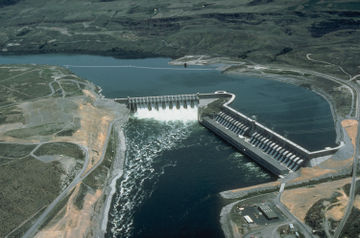Flow rate: Difference between revisions
J.williams (talk | contribs) m (1 revision imported) |
No edit summary |
||
| Line 1: | Line 1: | ||
[[Category:Done 2015-09- | [[Category: Done 2015-09-06]] | ||
[[File:Chief_Joseph_Dam.jpg|360px|thumb|right|Figure 1. [[Run-of-the-river systems]] like the one shown above tend to have larger flow rates than hydro dams that use [[reservoir]]s.<ref>Wikimedia Commons. (August 24, 2015). ''Chief Joseph Dam'' [Online]. Available: https://upload.wikimedia.org/wikipedia/commons/6/6c/Chief_Joseph_Dam.jpg</ref>]] | [[File:Chief_Joseph_Dam.jpg|360px|thumb|right|Figure 1. [[Run-of-the-river systems]] like the one shown above tend to have larger flow rates than hydro dams that use [[reservoir]]s.<ref>Wikimedia Commons. (August 24, 2015). ''Chief Joseph Dam'' [Online]. Available: https://upload.wikimedia.org/wikipedia/commons/6/6c/Chief_Joseph_Dam.jpg</ref>]] | ||
<onlyinclude>'''Flow rate''', sometimes represented by ''Q'', is the number of cubic [[meter]]s of [[water]] that pass through a [[hydroelectric facility|hydroelectric]] [[power plant]] per second.<ref name=boyle>G. Boyle. ''Renewable Energy: Power for a Sustainable Future, 2nd ed. Oxford'', UK: Oxford University Press, 2004.</ref> Thus, the unit for flow rate is meters cubed per second (<m>m^3/s</m>).</onlyinclude> Understanding the flow rate of the stream or river used for a [[hydropower]] generation plant is vitally important to predicting the available amount of hydropower. This, along with the [[head drop]] of the stream or river are the two values necessary to calculate the available [[power]].<ref name="RE1">REUK. (August 24, 2015). ''Calculation of Hydro Power'' [Online]. Available: http://www.reuk.co.uk/Calculation-of-Hydro-Power.htm</ref> | <onlyinclude>'''Flow rate''', sometimes represented by ''Q'', is the number of cubic [[meter]]s of [[water]] that pass through a [[hydroelectric facility|hydroelectric]] [[power plant]] per [[second]].<ref name=boyle>G. Boyle. ''Renewable Energy: Power for a Sustainable Future, 2nd ed. Oxford'', UK: Oxford University Press, 2004.</ref> Thus, the unit for flow rate is meters cubed per second (<m>m^3/s</m>).</onlyinclude> Understanding the flow rate of the stream or river used for a [[hydropower]] generation plant is vitally important to predicting the available amount of hydropower. This, along with the [[head drop]] of the stream or river are the two values necessary to calculate the available [[power]].<ref name="RE1">REUK. (August 24, 2015). ''Calculation of Hydro Power'' [Online]. Available: http://www.reuk.co.uk/Calculation-of-Hydro-Power.htm</ref> | ||
Flow rate simply represents the [[volume]] of water that can be captured and then re-directed by a dam to flow across a [[turbine]] [[generator]] to move it and [[electricity generation|generate electricity]]. The larger the flow - meaning the larger flow rate value - the more energy is available to be converted to [[electricity]].<ref name="RE1"/> | Flow rate simply represents the [[volume]] of water that can be captured and then re-directed by a dam to flow across a [[turbine]] [[generator]] to move it and [[electricity generation|generate electricity]]. The larger the flow - meaning the larger flow rate value - the more [[energy]] is available to be converted to [[electricity]].<ref name="RE1"/> | ||
Both a high flow rate and a high head aren't necessary for a hydroelectric power plant to be viable.<ref name="RE1"/> If there is a high flow rate, the head doesn't need to be as high as the sheer amount of water flowing through the dam is sufficient to move turbines. Conversely, if the water is falling a large distance it isn't as important for a large volume of water to flow to the turbines. | Both a high flow rate and a high head aren't necessary for a hydroelectric power plant to be viable.<ref name="RE1"/> If there is a high flow rate, the head doesn't need to be as high as the sheer amount of water flowing through the dam is sufficient to move turbines. Conversely, if the water is falling a large distance it isn't as important for a large volume of water to flow to the turbines. | ||
==References== | ==References== | ||
{{reflist}} | {{reflist}}[[Category:Uploaded]] | ||
[[category: Ed edit]] | |||
Revision as of 19:54, 17 September 2015

Flow rate, sometimes represented by Q, is the number of cubic meters of water that pass through a hydroelectric power plant per second.[2] Thus, the unit for flow rate is meters cubed per second (). Understanding the flow rate of the stream or river used for a hydropower generation plant is vitally important to predicting the available amount of hydropower. This, along with the head drop of the stream or river are the two values necessary to calculate the available power.[3]
Flow rate simply represents the volume of water that can be captured and then re-directed by a dam to flow across a turbine generator to move it and generate electricity. The larger the flow - meaning the larger flow rate value - the more energy is available to be converted to electricity.[3]
Both a high flow rate and a high head aren't necessary for a hydroelectric power plant to be viable.[3] If there is a high flow rate, the head doesn't need to be as high as the sheer amount of water flowing through the dam is sufficient to move turbines. Conversely, if the water is falling a large distance it isn't as important for a large volume of water to flow to the turbines.
References
- ↑ Wikimedia Commons. (August 24, 2015). Chief Joseph Dam [Online]. Available: https://upload.wikimedia.org/wikipedia/commons/6/6c/Chief_Joseph_Dam.jpg
- ↑ G. Boyle. Renewable Energy: Power for a Sustainable Future, 2nd ed. Oxford, UK: Oxford University Press, 2004.
- ↑ 3.0 3.1 3.2 REUK. (August 24, 2015). Calculation of Hydro Power [Online]. Available: http://www.reuk.co.uk/Calculation-of-Hydro-Power.htm

